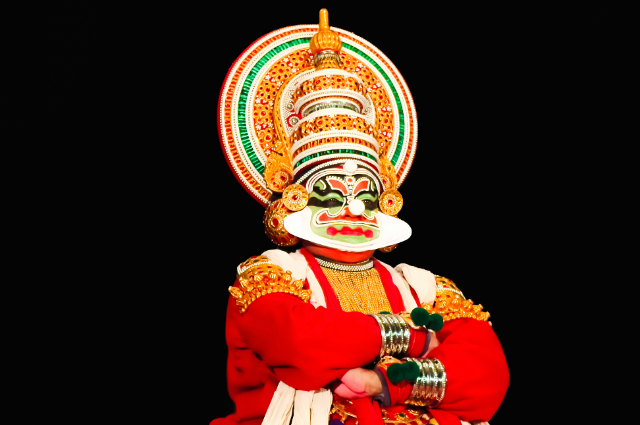
Photo by Dileesh Kumar on Unsplash/ Representative Image
On Vijayadashami, a festival that symbolizes the triumph of good over evil and traditionally marks the beginning of new learning in Kerala, the hallowed grounds of Kerala Kalamandalam witnessed something unprecedented. Sixteen-year-old Sabri, along with her younger companion Nafla, stepped onto the stage to perform Kathakali not as spectators of tradition, but as active participants reshaping it. What made this moment truly historic was not just their debut performance, but the fact that they are the first Muslim girls to formally learn and perform this ancient Hindu art form at one of India's most prestigious institutions for classical arts.
This development speaks to a larger narrative about artistic inclusivity, the breaking down of invisible barriers, and the organic secularism that has always existed in India's artistic traditions, even when covered by contemporary rhetoric.
Journey of a Pioneer
Sabri's journey to this historic arangetram (debut performance) is a testament to determination, family support, and institutional courage. The young performer portrayed Lord Krishna a character deeply rooted in Hindu mythology with such conviction that it transcended religious boundaries and touched upon the universal language of art. Her performance, alongside 11-year-old Nafla, wasn't merely about executing mudras and expressions; it represented the democratization of an art form that has for centuries remained within certain community boundaries.
What strikes most observers about Sabri's story is the quiet revolution it represents. This isn't about tokenism or forced integration. This is about a young girl who was drawn to Kathakali's grandeur, who pursued it with passion, and who found an institution willing to embrace her ambition. The fact that Kerala Kalamandalam, an institution founded to preserve and promote Kerala's classical arts, opened its doors to these young Muslim students speaks volumes about the institution's commitment to art over identity politics.
Family as the Foundation
Behind every barrier-breaking achievement stands a support system that dares to dream differently. Sabri's family her parents and relatives have made a conscious choice to encourage her artistic pursuit, fully aware that they were venturing into uncharted territory. In a society where cultural and religious lines often dictate children's educational and artistic choices, this family chose to prioritize their daughter's passion over societal expectations. Sabri's parents deserve recognition not just for permitting, but for actively enabling their daughter's journey into an art form that many might have considered 'outside' their cultural domain.
Kathakali and an Art Beyond Boundaries
Kathakali, with its elaborate costumes, complicated makeup, and stylized movements, has long been considered one of Kerala's most treasured cultural assets. Traditionally, it has been a male-dominated art form, depicting stories primarily from Hindu epics like the Mahabharata and Ramayana. The characters be they gods, demons, or heroes are brought to life through years of rigorous training in facial expressions ("rasas"), hand gestures ("mudras"), and body movements.
The beauty of classical Indian art forms lies in their ability to communicate universal human emotions and philosophical concepts. When Sabri performed as Krishna, she wasn't merely imitating movements learned by rote. She was embodying a character that represents love, wisdom, and divine playfulness qualities that transcend religious identities. This is where art reveals its true power: in its capacity to dissolve boundaries and create shared emotional experiences.
Institutional Courage of Kerala Kalamandalam
While celebrating the students, one must also acknowledge the institutional vision that made this possible. Kerala Kalamandalam, established in 1930 by the revered poet Vallathol Narayana Menon, has always positioned itself as a guardian of Kerala's artistic heritage. By admitting Sabri and Nafla into their Kathakali program, the institution demonstrated that preserving tradition doesn't mean fossilizing it. It means keeping it alive and relevant by allowing it to grow and embrace new practitioners.
This decision required courage. In an era where every cultural gesture is scrutinized through the lens of identity politics, Kerala Kalamandalam chose artistic merit over religious considerations. They recognized talent and passion, providing these young girls with the same rigorous training that all Kathakali students receive. This is institutional secularism in its most practical, unglamorous, and effective form.
Reflection of Kerala's Syncretic Culture
Sabri's performance represents a natural extension of Kerala's syncretic traditions. Kerala has historically been home to diverse religious communities living in relative harmony. The state's cultural landscape has always featured cross-pollination, whether in cuisine, music, or festival celebrations. However, this organic secularism has been increasingly challenged by rising communal polarization across India.
Sabri's debut arrives at a crucial juncture when positive narratives of cultural integration are desperately needed. It reminds observers that India's civilizational strength has always been in its ability to absorb, adapt, and create spaces where different traditions can coexist and even merge. The image of a young Muslim girl embodying Krishna on Vijayadashami is powerful precisely because it defies the narrow categorizations that contemporary politics tries to impose on Indian culture.
A New Beginning
This historic performance at Kerala Kalamandalam inspires cautious optimism. Sabri and Nafla have opened a door, but keeping it open and widening it further will require sustained effort from institutions, families, and society at large. Their debut on Vijayadashami carries symbolic weight: just as the festival celebrates new beginnings and the victory of knowledge over ignorance, these young performers herald a future where artistic excellence trumps religious identity, where tradition evolves without losing its essence, and where young Indians can pursue their passions unrestricted by invisible boundaries.
The applause that greeted Sabri's performance was not just for a well-executed debut; it was a collective acknowledgment that Indian culture is richer when it is more inclusive, that artistic traditions gain strength through diversity, and that the future of classical arts lies in opening them up to all who approach them with dedication and respect. This is the India worth striving for one performance, one barrier broken, one young dreamer at a time.
. . .
References:
